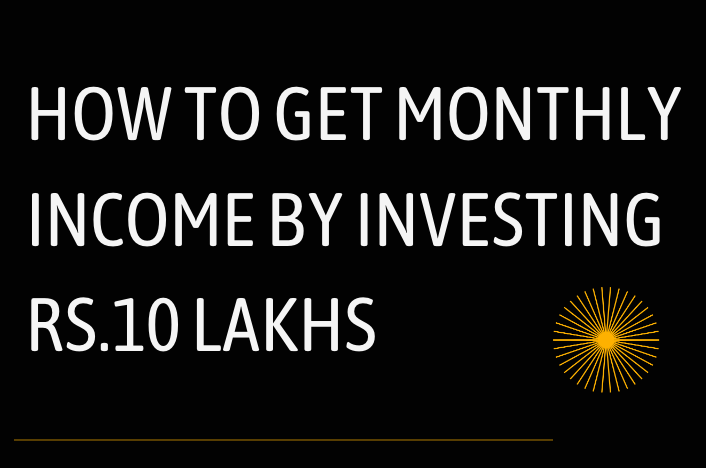Acquiring monthly income through investment can help individuals gain access to extra funds, which helps meet near-term financial requirements. Investing money through risk-free avenues and generating monthly income is one of the most effective and feasible ways towards wealth management.
In this regard, a Fixed Deposit is one such investment option that can deliver regular monthly payouts. So, if you have Rs.10 Lakhs, you will earn the Rs.10 Lakhs FD interest per month, which will lower your financial burden.
Read on to know how you can obtain a monthly income through FDs.
How to Calculate Monthly Payout on FDs?
Typically, banks and financial institutions offer two types of FDs. They are:
- Cumulative FDs
- Non-cumulative FDs
With a cumulative FD, you can invest a lump sum amount over a fixed tenure and earn interest on that upon maturity. Note that cumulative FDs generally feature a higher rate of interest.
On the other, a non-cumulative FD is the one where you earn regular payouts depending on your investment. The liberty of choosing the payment frequency lies with you. In this regard, you can choose to avail payouts monthly, quarterly, half-yearly or annually. This option is feasible for individuals seeking regular income to meet financial goals.
You can calculate your non-cumulative FD investment payout by using an FD calculator. Simply follow these steps:
Step 1: Visit the official portal of your bank
Step 2: Navigate to the FD calculator page
Step 3: Enter the investment amount, select the FD type, type of customer and investment tenure
After providing all these details, you will receive information pertaining to your Rs.10 Lakhs FD interest per month. You can further change the digits until you arrive at an amount that suits your financial goals.
What are the Benefits of Monthly Income FD Plans?
The various features and benefits exhibited by monthly income FD plans are mentioned below:
- This scheme is adaptable, with no maximum amount of money that can be invested. It enables people to invest in the scheme based on their financial capabilities and requirements.
- A monthly income scheme is more liquid than most other investment schemes. Because there is no lock-in period, investors can withdraw their funds at any time to meet an unexpected emergency.
- Investors in the monthly income scheme are not required to pay a processing fee to open an account. It also has a low exit-load of less than 1% of the total investment.
- Investors receive guaranteed monthly payouts, as the interest rate on FDs do not depend on market volatility. It remains fixed even during unstable market conditions, ensuring you receive assured monthly payouts.
- Monthly income schemes are managed by professional fund managers knowing the working of the market. They track schemes and make all of the decisions about when and how much money should be converted from debt to equity.
You can find various FDs like the Bajaj Finance Fixed Deposit that offer substantial payouts, depending on the investment amount and rate of interest. In addition, you can open an FD account online by following a few easy steps. In addition, you can also compare different FD plans on Bajaj MARKETS, which is a diversified marketplace housing different Fixed Deposit offers by leading banks and financial institutions.
Things to Consider Before Investing in FDs
Before you seek to earn payments on Rs.10 Lakhs FD interest per month, consider the following factors:
Tenure
Determine the duration of your deposit before investing in an FD. The duration can range from 7 days to 10 years. It is critical that you carefully consider the deposit’s tenure because there is a penalty for early withdrawal. This might reduce the overall interest earned on your deposit, lowering your payouts.
Interest rate
The RBI establishes guidelines for the interest rates banks and financial institutions may offer on FDs. Banks have the authority to set interest rates within the prescribed limits. As a result, the interest rate on a fixed deposit varies from bank to bank, but few people realise that it also varies according to the deposit’s tenure.
TDS
The interest earned on a fixed deposit is liable for tax if income exceeds Rs. 40,000 in a fiscal year. For senior citizens, the threshold is Rs.50,000. In this situation, the bank deducts 10% of the interest earned and credits the remaining balance to your account.
However, if you do not fall into the tax bracket, or if your annual does not exceed Rs.2.5 Lakhs, you can opt for a TDS refund by submitting Form 15H or 15G.
Considering these factors will help you make the most out of your Rs.10 Lakhs FD interest per month. However, before investing in non-cumulative FDs, consider reading the terms and conditions thoroughly.

Krishna Murthy is the senior publisher at Trickyfinance. Krishna Murthy was one of the brilliant students during his college days. He completed his education in MBA (Master of Business Administration), and he is currently managing the all workload for sharing the best banking information over the internet. The main purpose of starting Tricky Finance is to provide all the precious information related to businesses and the banks to his readers.




